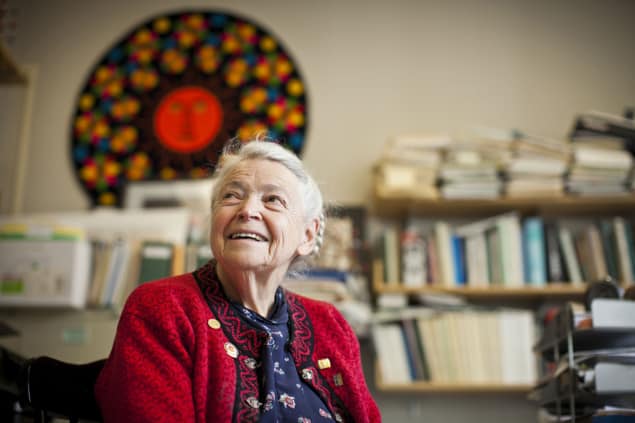Jess Wade reviews Carbon Queen: the Remarkable Life of Nanoscience Pioneer Mildred Dresselhaus by Maia Weinstock

Mildred Dresselhaus, materials-science pioneer and nanotechnology trailblazer, should be a household name. Her contributions to science were immense: unravelling the electronic structure of carbon and paving the way for the discovery of fullerenes, carbon nanotubes and graphene. She was the first woman to be appointed Institute Professor at the Massachusetts Institute of Technology (MIT), which is the highest title that is awarded there. She was also the first woman to win a National Medal of Science in the category of engineering (awarded by the US president) and the first individual winner of the Kavli Prize in Nanoscience.
For too long, Dresselhaus’ story has not been told. With Carbon Queen: the Remarkable Life of Nanoscience Pioneer Mildred Dresselhaus, science writer Maia Weinstock looks to rectify that. It is an endlessly inspiring biography of a scientific superstar, carefully researched and lovingly written.
In an effort to identify the origins of Dresselhaus’ brilliance, Weinstock wonderfully weaves together anecdotes shared by the scientist throughout her life. The author herself first came across Dresselhaus 20 years ago, when she was researching an article on important women scientists for Discover magazine. When Weinstock joined the MIT News Office in 2014 she was in awe of the scientist, who had truly achieved legendary status at the university. In her mid-80s she hadn’t remotely slowed down, and her science continued to be ground-breaking.
Millie, as Dresselhaus was known to her students and colleagues, was born to Polish–Jewish immigrants in 1930, and grew up in a rough area of the Bronx, New York City, during the Great Depression. Weinstock affectionately refers to her as Millie throughout, which, combined with her in-depth descriptions of her personal life and sensational research career – and learning that Dresselhaus became known for her Scandinavian sweaters – portray her as the relatable hero science so desperately needs. Alongside her remarkable scientific discoveries, Dresselhaus made highly influential contributions to education and policy, valued mentoring, and was entirely committed to training the next generation of nanoscience researchers.
To support her family, Dresselhaus worked several jobs – as a tutor in an elementary school and as a labourer in a zipper factory. But she was inspired by reading Madame Curie, an award-winning biography of Marie Curie written by her daughter Eve, and spent her childhood allowance on copies of National Geographic magazine. In 1948 Dresselhaus enrolled in Hunter College in New York, where Rosalyn Yalow, her physics professor – and a future Nobel laureate – encouraged her to pursue science.
After graduating in 1951, Dresselhaus spent a year as a Fulbright scholar at the Cavendish Laboratory in Cambridge, UK, where she finally gained the confidence that she could succeed as a scientist. She worked on a PhD at the University of Chicago, where she studied how magnetic fields impact superconductors, under the supervision of Enrico Fermi. Dresselhaus credited Fermi with training her to “think like a physicist”. During her time at Chicago, she would walk with him into the lab, speaking freely about research directions and new opportunities. Fermi’s wife, Laura, would cook Italian food for his research group once a month, and Dresselhaus said that it was “the ambience and the friendliness in that household that made us really enjoy physics”.
While she only knew Fermi for one year, his approach to teaching, student supervision and public service “left an enduring impression” on Dresselhaus. Weinstock explains that she would become an extraordinary educator, described by former student Aviva Brecher as “the best, clearest and most caring teacher” they ever had at MIT. Her courses on solid-state physics are still taught today.
Dresselhaus’ resilience and determination meant that she succeeded in a world that was not welcoming to her
Dresselhaus’ resilience and determination meant that she succeeded in a world that was not welcoming to her. At the time, a lot of people still believed that “a woman’s place is in the home”. Her contributions to nanoscience were nothing short of incredible. She studied thermoelectric materials, as well as the magnetic, optical and electrical properties of semimetals, creating novel nanomaterials that provided the foundation for lithium-ion batteries, fullerenes and carbon nanotubes. Her attention to detail and creativity allowed her to formulate the design rules for nanomaterials, with a focus on sustainability.
Dresselhaus once remarked that “the take-home message here”, when it came to her materials research in general, “is that it’s not a bad idea to try to make the world a better place, when called upon to do so”. Weinstock emphasizes the impact of Dresselhaus’ research through the words of her collaborators and former students, who describe her perfect scientific intuition, inexhaustible energy and indelible legacy.
Like the subject of her book, Weinstock is a creative and committed advocate for women scientists. She led the successful 2016 “LEGO Ideas” campaign to create a “Women of NASA” LEGO set, honouring notable NASA pioneers (including Katherine Johnson and Margaret Hamilton). She recently celebrated six innovative women computer scientists in the “Women of Computer Science” LEGO set (featuring Grace Hopper and Gladys West). In fact, her first real-life interaction with Dresselhaus on arriving at MIT was to hand her a custom Weinstock/LEGO minifigure of Dresselhaus.
I have to admit, when I finished Carbon Queen I was left heartbroken that I had never met Dresselhaus, who died in 2017. I too study carbon-based nanomaterials, am fascinated by magneto-optic phenomena, and am passionate about training physicists of the future. So I flicked back to the beginning and started reading again. With Carbon Queen, Weinstock does more than tell the story of a brilliant scientist’s life; she transports you into a world of curiosity and wonder, driven by enthusiasm and persistence. It’s a world that I certainly want to be part of.
- 2022 MIT Press $24.95hb 320pp



